Q&A – Ask Neil: April 25, 2024
(Please read these instructions carefully.)
Before you post your question, please look at recent issues to see if someone else has already asked it. You might find your answer there.
How to submit your question…
(Note: You may need to allow a pop-up window to come up in order to get the link for sending your photo(s). If you have already submitted your question and didn’t see the pop-up window, please click here.)
• Click the link provided below to post your question. After you submit your question, a new window will pop up giving you the address to which you can e-mail a SHARP, HIGH-RESOLUTION PHOTO to accompany your question. Please DO NOT SEND THUMBNAIL PHOTOS in case I need to zoom in to see things.
• Click here to post your question.
• Please ONLY POST YOUR QUESTION ONE TIME. We can only accept a set number of questions each week, and when we get duplicates it costs other people their chances.
• One question per reader, please.
• Please use this only for posting questions – not for standard emails.
• Watch for your answer in the following week’s e-gardens.
• I choose those of greatest general interest. For example, plant IDs seldom make the cut.
• I must have your first name or initials.
• I must have your city or county. (Texas is a very large state.)
QUESTION 1
IS THIS SUN SCALD ON TRUNK OF CHINESE PISTACHIO?
Question: I bought several trees from one of your recommended sources last year, one of them a Chinese pistachio. The warranty is almost up. They declined to wrap the trunk and now I am seeing what appears to be damage on the west side. What should I do? Karen R., Cooke County.
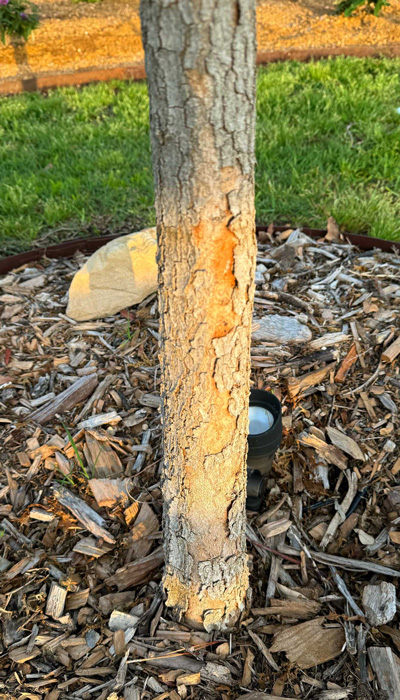
Answer: To my eye this looks more like normal bark sloughing that happens as a tree’s trunk expands with spring growth. There also appears to be bright late-afternoon sunlight with shadows above. I wouldn’t be concerned based on this photo. Sun scald, however, is a concern to me, and it’s my opinion that all thin-barked trees should be protected for their first couple of years in our landscapes with paper tree wrap from the ground to the lowest branches.
You could still wrap the trunk now if you wished, although if damage were going to occur, it probably already has. It takes 2-3 years to become visible. By that time vertical cracks in the wood of the trunk develop. You don’t see that in your photo.
I’m also hoping that the root flare is right at the soil surface. You might want to scoop some of that soil away from the trunk to make sure it’s not planted too deeply. Good luck with it.
If they planted the tree for you, take photos with date stamps on them to document its progress. Include a whole-tree photo to show the vigor of the canopy from year to year. Hopefully they’ll understand that you were concerned before the one-year warranty ran out.
QUESTION 2
WILL OUR CRAPE MYRTLE BE OK AFTER SERIOUS HAIL ONE MONTH AGO?
Question: We had heavy hail a month ago. I noticed last week this damage to the bark of our crape myrtle. It’s been there for 7 years, so it’s well established and hardy. Do I need to cover or protect or treat the damaged areas? It gets full afternoon sun. Danielle K., Little Elm, Denton Co.
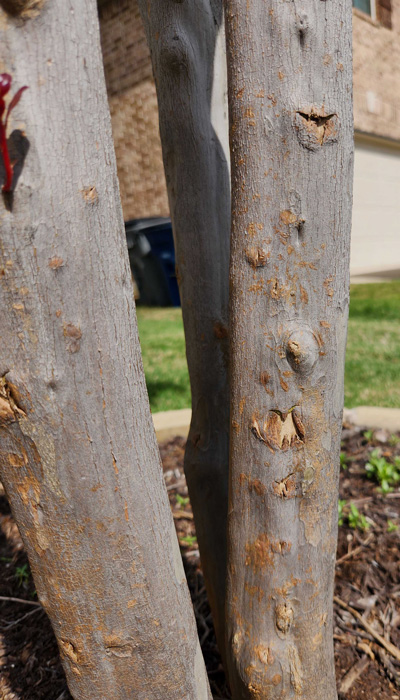
Answer: It will be just fine. If crape myrtles can survive the butchery we put them through with relentless topping, a bit of hail damage won’t bother them at all.
Damage becomes more serious with trees and large shrubs when hail hits horizontal branches. It bruises their upper tissues and decay can set in. I’ve seen large oaks hurt badly by it. Crape myrtles, however, should be able to recover just fine.
QUESTION 3
WHAT IS WRONG WITH MY PRIDE OF HOUSTON YAUPON HOLLY?
Question: I planted this Pride of Houston yaupon holly two years ago. Until now it has thrived. This spring, one trunk dropped most of its leaves and only has sparse new growth. This area of my garden collects water from both yards and stays wet but not submerged. Daniel D., Keller.
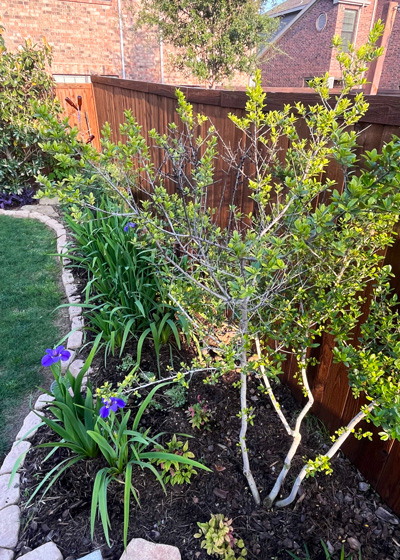
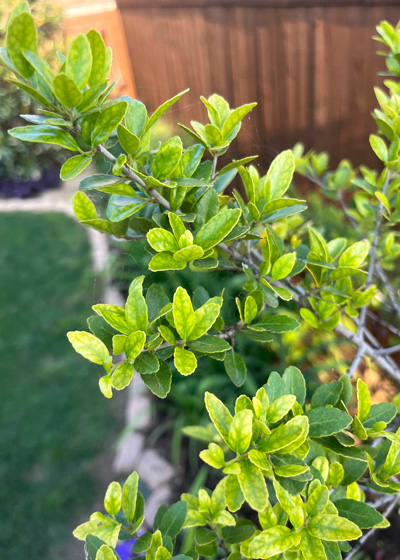
Answer: Your close-up photo shows classic symptoms of iron deficiency with its yellowed leaves with dark green veins showing more visibly on the newest growth first. (Notice how leaves a bit farther back on the twigs are more solid green. Those would be older leaves that were produced earlier.) So, I could suggest that you apply an iron supplement with sulfur included to help keep the iron soluble. My standard recommendation includes the warning to keep iron products off masonry and painted surfaces that could be stained.
But I got two warning signals. You gave me one when you said the area stays wet. Waterlogged soils damage roots, and that can lead to poor uptake of nutrients including iron. Adding more iron won’t help if it’s wet soil that is causing the problem in the first place.
The second red flag came way down at the bottom of your photo. It looks like you also have dwarf nandinas growing at the base of your yaupon. They show even worse iron deficiency. That points even more strongly to some kind of soil problem with too much water and too little available iron.
My game plan would be:
• Trim the holly back by 20-25 percent to remove some of the stubble and to encourage regrowth.
• Apply an all-nitrogen fertilizer like you would use on the lawn followed by one watering. That should stimulate regrowth.
• Determine how the excess water is getting into the bed and take steps to stop it.
• Apply the iron/sulfur material for a short-term correction.
QUESTION 4
SHOULD I BE MOWING AND COLLECTING WEED SEEDS?
Question: I purchased a house three weeks ago – too late for pre-emergent. When I mow at a low mower height is it wise and beneficial to bag the clippings in the hope of capturing the grassy weed seeds to reduce future populations? M.A.D., Tarrant County.
Answer: It certainly won’t hurt. However, note that any weeds you’re seeing in seed now germinated last September. Time for that pre-emergent application would be August 25-September 5. You didn’t “barely” miss the application three weeks ago for these weeds.
QUESTION 5
SHOULD WE REMOVE HACKBERRY TREES?
Question: We will be building a house on one acre in the next few months. We have two hackberry trees, 27 and 21 ft. tall. The house will be within 25 to 30 ft. of the trees. Should they be removed? Ron C., Keller.
Answer: Not necessarily. Hackberries may not be the best trees on the planet, but those are large trees, so they do have value. You can always take them out later if you decide they present a threat to your house or gardens. If you design carefully, it shouldn’t be any more difficult then than now.
Hackberries are spreading trees. It’s not uncommon for their branches to extend 30 to 35 ft. out from the trunk. Since their wood is brittle and can break in wind and ice storms, don’t let them overhang your roof.
Would I plant a hackberry in my landscape? No. Would I take a 20-ft. one out? Likely not.
QUESTION 6
WHAT KIND OF GRASS IS THIS, AND HOW DO I GET RID OF IT?
Question: What type of grass is this, and how can I get rid of it? If herbicides don’t work, can I pull it out? If I don’t remove it, will it continue to spread? David Y., Rowlett.
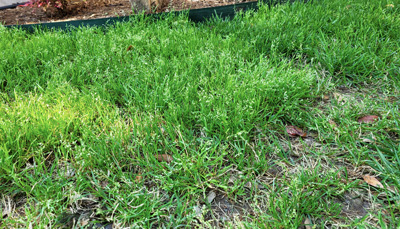
Answer: Welcome to annual bluegrass, Poa annua. It’s the scourge of fine lawns, commercial turf, and athletic fields all over America. It germinates in early fall, establishes itself in late fall and winter, then flowers and goes to seed in the spring. It dies as it turns hot in May, so you’re about to see it disappear even if you do nothing.
Mark your calendar to apply pre-emergent granules between August 25 and September 5 late each summer before it starts the next growth cycle. Once it has started growing there is nothing you can apply to kill it that won’t also kill your desirable turfgrass.
Several southern states are reporting that pre-emergents are not giving total control of this weed – that it appears to have built up resistance to the products. I’ll be doing online research late this summer to see if any new products have come into the market that offer better results. For now, though, Dimension, Balan, and Halts offer your best chances.
QUESTION 7
WHAT ARE THESE SMALL BLACK BUGS ON MY YUCCAS, AND HOW CAN I STOP THEM?
Question: Some tiny black bugs are crawling all over the leaves of my yucca plants. What are they, and do I need to worry about controlling them? K. R., Cooke County.
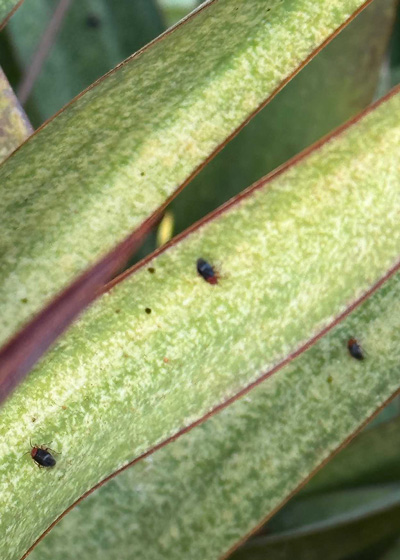
Answer: These are yucca plant bugs, and the leaf discoloration is very similar to what you’ll see done by lace bugs to pyracanthas, azaleas, Boston ivy, and sycamores, among many others. It makes the plants look terrible, so you’ll definitely want to apply a labeled insecticide. Here is a fact sheet from North Carolina State University.
